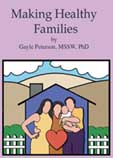Characteristics of Healthy Families
created by Gayle
Peterson, including
Excerpts from Making
Healthy Families

“A healthy family is neither
necessarily average, nor merely lacking in negative characteristics.
Rather it has described positive features”[1]
We have all become familiar with the concept of “dysfunctional”
as it applies to communication and relationships. We may have even
concluded that we come from dysfunctional family backgrounds
ourselves. The term itself may be overused and perhaps misused but
it gets the point across. Thanks to the media and John Bradshaw’s
popularity, we understand that we need not recapitulate the past.
Indeed past pain in relationships can be circumvented to some degree
by learning to change that which does not promote health and happiness.
So far, so good, but what exactly needs change and what does not?
We don’t want to throw the baby out with the bathwater, excuse
the old adage. What particular points of strength did our families
teach us? What are the hallmarks of families that seem to flourish
in an atmosphere of warmth and ease, even under stressful life events?
Too often we study what goes wrong, but this does not always give
us a picture of how things go “right”!
Paying attention to positive elements in human relationship
results in more than the sum of its parts. By studying the characteristics
of what contributes to health and well being in family systems, you
may find yourself thinking differently about your own family experience.
Expectations that reside in past negative experience can cause you
to miss opportunities for positive interaction with family members.
Wondering what will bring joy or soothing, instead of reliving irritations
which presuppose past negative attitudes can constructively alter
relationships.
In 1976 a group of family researchers collaborated
in the Timberlawn study of healthy families. Their work produced the
first published report of a detailed examination of well-functioning
families. Robert Beavers, MD continued to develop research on healthy
family systems and what makes them tick. The following characteristics
of healthy families is the culmination of 30 years of research by
Beavers and his associates. The characteristics listed on your tip
sheet for this week represent one research team’s[2] attempts
to describe what goes on in families that contributes to healthy relationships.
It is not all inclusive, nor does it express one way to be
as a family. These are simply observations from a variety of family
cultures that have been identified as having positive impact
on growth and adaptation. Each family is its own unique culture. But
all families, no matter where they are, do basically the same thing.
Families exist to nurture the growth and development of their members.
Each family is like a garden. The characteristics below are some of
the nutrients you may wish to consider in tilling the soil. Consider
the questions below with reference to your childhood experience of
family and your own current family situation.
 Go
to: Exercise in Characteristics of Healthy Family Relationships Go
to: Exercise in Characteristics of Healthy Family Relationships
[1] Epstein, Bishop, Ryan, Miller and Keitner,The McMaster
Model View of Healthy Family Functioning, p,139 in Normal
Family Processes, edited by Froma Walsh, 2nd edition, The Guilford
Press, N.Y., 1993.
[2] Beavers, R. and Hampson, R.Measuring Family Competence:
The Beavers Systems Model in Normal Family Processes, edited
by Froma Walsh, 2nd edition, The Guilford Press, N.Y., 1993.
|